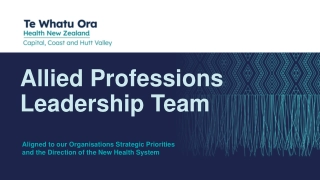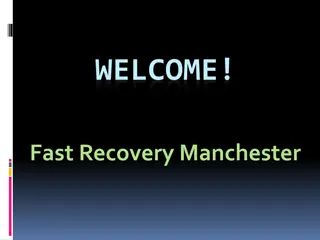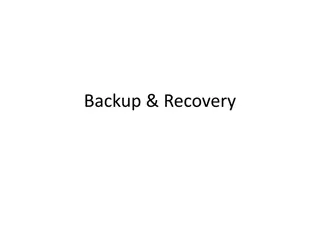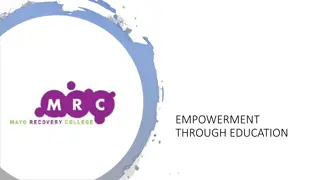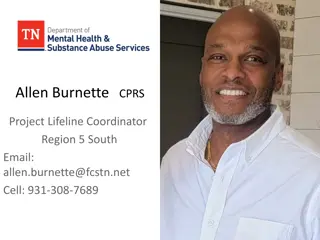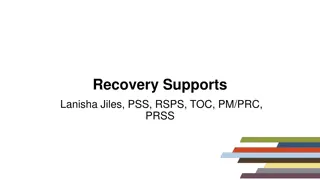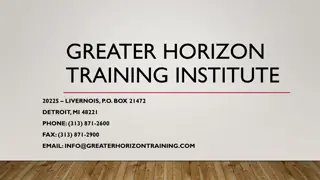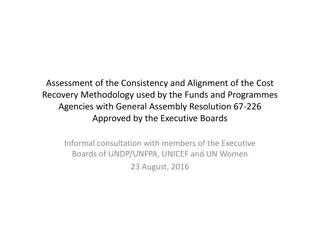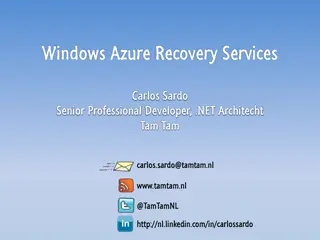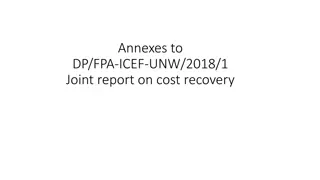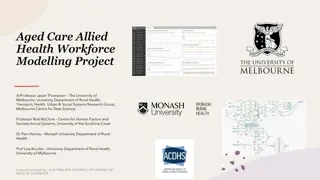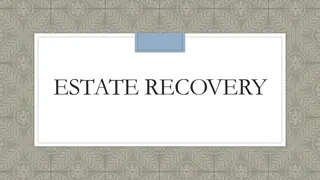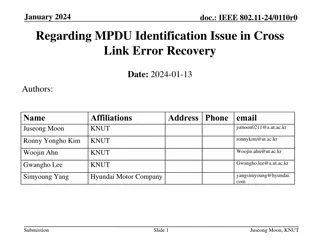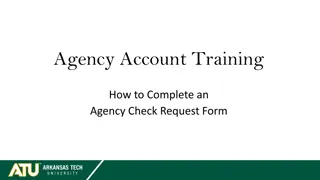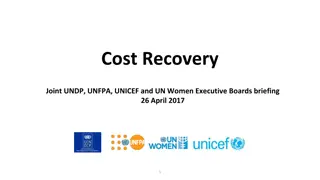Completing the Allied Health Recovery Request Guidelines
The Allied Health Recovery Request (AHRR) replaces EP and Physio Management Plans for CTP and WorkCover bills. It includes sections for client details, clinical assessment, and capacity evaluation. Focus on the client's strengths and capacities in various settings such as work, home, and the community. The AHRR aims to facilitate coordinated recovery planning among allied health professionals and medical providers.
Download Presentation

Please find below an Image/Link to download the presentation.
The content on the website is provided AS IS for your information and personal use only. It may not be sold, licensed, or shared on other websites without obtaining consent from the author. Download presentation by click this link. If you encounter any issues during the download, it is possible that the publisher has removed the file from their server.
E N D
Presentation Transcript
Completing the Allied Health Recovery Request Daniel Willoughby
AHRR The allied health recovery plan replaces the EP and Physio Management Plans. It is to be used for both CTP and WorkCover Bill $25 Plus gst for the first AHRR that you do under code OAS003 (this is in front desk already). All subsequent AHRR do not attract billing.
Section 1 Client Details Self explanatory fill in the sections.
Section 2 Clinical Assessment Box 1 Your diagnosis for the compensable injury as assessed at the time of submission. EPs to basically complete diagnosis according to med cert and state that. Tick Box 1 and 2 Whether you have liaised with the treating medical practitioner and your opinion about the consistency of diagnosis. If your diagnosis differs, it is recommended that you contact the treating medical practitioner to discuss the difference and any implications for management of the client. Record your discussion in the last box in section 2. Box 2 Current signs and symptoms for the compensable injury (include reported/observed and relevant objective measures). Often this information will include reporting on impairment level factors, for example pain or stress.
Section 2 Clinical Assessment Box 3 Details of any pre-existing factor(s) directly relevant to the compensable injury. Box 4 Details of any other allied health or medical provider(s) treating your client for the compensable injury (with name, profession and contact details if available). You are encouraged to contact the provider(s) to facilitate coordinated recovery planning and to provide a brief summary of the communication. Tick Box 3 Positon Description why do they want you to have this?????
Section 3 Capacity The term Capacity relates to the activity and participation level as described in the International Classification of Functioning, Disability and Health as outlined in the Clinical Framework. Report on your client s capacity, with an emphasis on activity and participation at work, home and the community. Focus on your client s strengths, not limitations (that is, describe what they can do, rather than what they cannot do). Include: what your client was doing prior to the injury their capacity (or function) at the time of assessment or the last AHRR (whichever is the most recent) their current capacity. This will provide a clear picture of how your client is progressing with intervention. Use the worker s job description/work duties: Consider the duties the worker is required to do and integrate those activities into their treatment.
Section 3 Capacity Why are they now asking us to focus on community & home as well as work??
Section 3 Capacity Box 3 - Other Factors Provide details about any factors you believe may be impacting on return to/recovery at work and include recommendations to address these barriers. Consider the biological, mental health, psychological, social and other factors that can impact recovery and independence. It is helpful to include an objective example. For instance, unhelpful beliefs (fear avoidance) , could be recorded as, Ms X reported she avoids heavy lifting because she is concerned she will re-injure her shoulder. Where you have used a specific tool to identify risk factors/barriers, record this here. Scales for identifying key risk factors include, but are not limited to: persisting pain (for example, measures of catastrophising, fear-avoidance beliefs, and self-efficacy) disability and pain measures (for example, Multidimensional Pain Inventory, rebro Musculoskeletal Pain Questionnaire ( MPQ), Neck Disability Index (NDI) and Visual Analogue Scale (VAS)) psychological measures (Beck Depression Inventory (BDI 11), Beck Anxiety Inventory (BAI), Depression, Anxiety, Stress Scale (DASS), Symptom Checklist (SCL9OR), FACTORWEB checklist, Expectation of Recovery Do you think you are going to get better soon? and to screen for post- traumatic stress the Impact of Event Scale (EIS)).
Whats The Difference between section 2 (Clinical Findings) and section 3 (Capacity).
Section 4 Recovery Plan Date service commenced - For a Tier 1 allied health practitioner, this date may be before the submission of the first AHRR. Indicate the number of sessions you have provided before submitting this AHRR. AHRR start date and end date
Section 4 Recovery Plan Client Goals: This section provides information about your client s goal(s). Goals are what your client wants to achieve, that is, why the client is undertaking the rehabilitation program and why you (and possibly other allied health practitioners) are providing intervention. The client may have just one overall goal of treatment, or they may have several goals. Goals may be longer than the AHRR period. Goals should be developed by your client in collaboration with you and should be SMART: Specific, Measurable, Achievable, Relevant, and Timed. They may carry over more than one AHRR.
Section 4 Recovery Plan Client steps Client steps describe the activity/behaviour the client needs to be able to do in order to achieve their goal. Each goal is likely to have a number of steps and each step needs to describe one behaviour/activity only. The steps and actions for each goal are to be achieved within the AHRR period.
Section 4 Recovery Plan Action plan There is one column for your client s action plan and a separate column for your action plan. The client action plan specifies self-management strategies they are expected to complete in order to achieve each step and goal. The service provider s actions describe the actions you need to take and when, for example, the type of intervention to be delivered. While you will only include the actions you are taking (and not the actions taken by other allied health practitioners), it is helpful to note how your intervention will compliment that of another practitioner if involved. Indicate if the request was completed during a consultation and the client agreed with the recovery plan, along with the date of agreement.
Section 4 Recovery Plan Click on the ADD button if your client wishes to include more than one goal.
Section 5 Services Requested Indicate the service type and number of consultations you propose to provide in this AHRR (up to a maximum of eight), as well as the frequency/timeframe for the delivery of the service type. The total cost will automatically populate in the form. The services requested should reflect your action plan listed in section 4. State the type of service being requested, whether it is a standard or group session, treatment of two distinct areas, etc. This should also cover any equipment or aids required for the worker to complete their action plan, and any request for case conferencing. If you are requesting time for case conferencing, enter the time in whole numbers and decimals in half hour increments, for example 0.5, 1.0, 1.5 hours. If you are a Tier 1 allied health practitioner, provide the SIRA code relevant to the service and enter the unit cost of the individual service based on the relevant Fees Order. You can find these at www.sira.nsw.gov.au.
Front Desk Integration?? Currently it looks as though we will be unable to create an integrated copy in front desk. Save the editable PDF as a template Will need to fill it out in its entirety for ths first plan (lucky we can bill) And then save to front desk as you normally would with any other attachment. Use this as the template for your subsequent AHRRfor that client (i.e: only update what needs to be updated.






